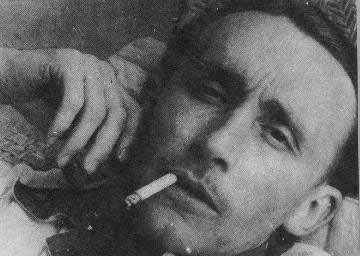
The sixth in a series of essays in honor of André Bazin.
Movies
achieve their highest aesthetic enchantment and greatest power to move
us emotionally by creating the illusion of spaces on the other side of
the screen which we can inhabit imaginatively. It's not the fact
that moving pictures move that moves us, it's the fact that movement is one of the chief ways that spatial illusions are created.
The coherence of the spatial illusion is crucial, not just in
individual shots but in the combination of shots through editing.
Single photographic images have a kind of built-in spatial coherence,
though they can be lit and composed in ways that counteract this
inherent quality — flattening the image, for example, so that we have
a hard time evaluating the depth of the space recorded. But even
images with spatial depth all shot in a single location can be combined
in such a way as to confuse us about the totality of the space they are
meant to suggest.
Almost any competent director can create the basic illusion of a
coherent space. The simplest way to do this is to follow
what has come to be the standard “studio style” — to start each scene
in a particular location with a master shot showing the overall space
of the scene and then cut in to closer shots of people or objects
within that scene, whose place in the spatial scheme has already been
established. There are endless variations of this method.
One can open a scene on a close-up of an object or an actor and then cut to a master
shot, but the master shot always serves as the ground of the illusion,
the point of orientation, even if that orientation is delayed.
We would find it very difficult to imaginatively inhabit a scene whose
spatial coherence was impossible or difficult to read — even if we
could construct it intellectually in our minds based on disparate
visual cues.
But the illusion of spatial coherence is merely the bottom line for
imaginative participation in a cinematic shot or scene. The
greatest, most pleasing and most powerful films create spatial
illusions that seduce us into the imaginary spaces of the work — which
invite or viscerally compel us into the spatial illusion.
This is where the art of cinema begins, and all great directors have
known how to seduce us in this way. They seem to have come into
possession of this knowledge by instinct, almost to have been born with
it. It doesn't, in other words, seem to be a knowledge that can
be taught, except perhaps by example. We have no language for
analyzing this knowledge systematically.
But there is a system to such seduction. It can be used in
complex and subtle ways to manipulate our emotional involvement in and
reaction to the narrative elements of a film. Allowing us to
enter the illusory space on screen at our own pace, as with a
deep-focus shot in which the choreography of the actors emphasizes the
space slowly and subtly, creates a different emotional effect than
hurtling us into an illusory space by a rapid movement of the camera,
one mounted on the top of a speeding train, for example. A master
shot looking down on the scene has different effect than a master shot
looking straight-on. A master shot which tracks in on a detail or
a character has a different effect than isolating the element with a
cut, and a master shot in which an element moves towards the camera
into a close-up has a different effect again.
Such variations of effect have been part of the crude methods of cinema
from the beginning, and account for the omnipresence of the chase as a
climactic device. Even if it has no logical raison d'etre,
a chase is almost always cathartic — by creating the illusion of rapid
movement through space the chase reaffirms and satisfies our attraction
to the basic
method and charm of cinema. It creates emotional involvement with
the characters, the pursuer and the pursued, quite beyond any conscious
involvement arising from the dramatic narrative. When Orson
Welles said that every great film was a chase he was acknowledging this
fundamental principal.
But when such visceral involvement is manipulated in complex ways in the service of
dramatic narrative, of character exposition, cinema rises to the level
of great art, an art founded in the creation of coherent and seductive
spatial illusions.
